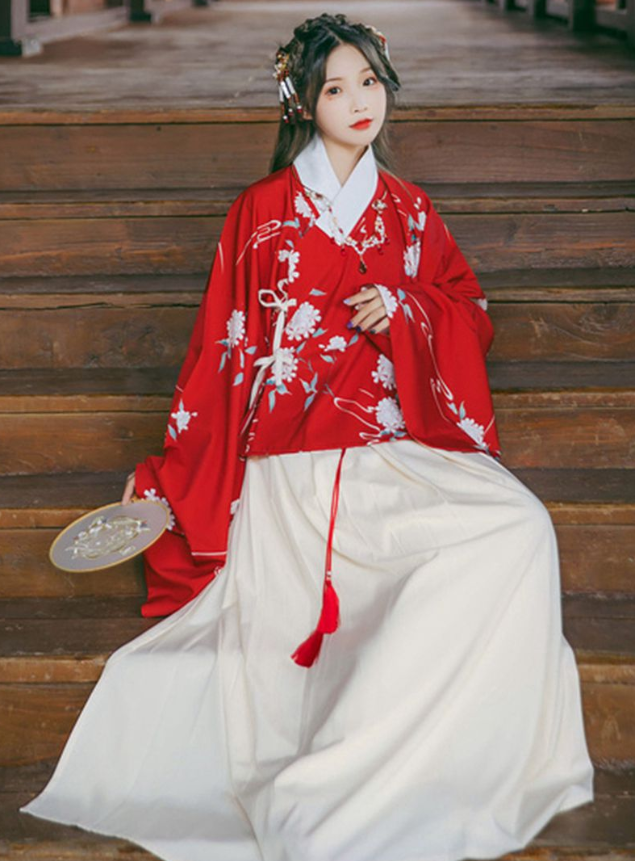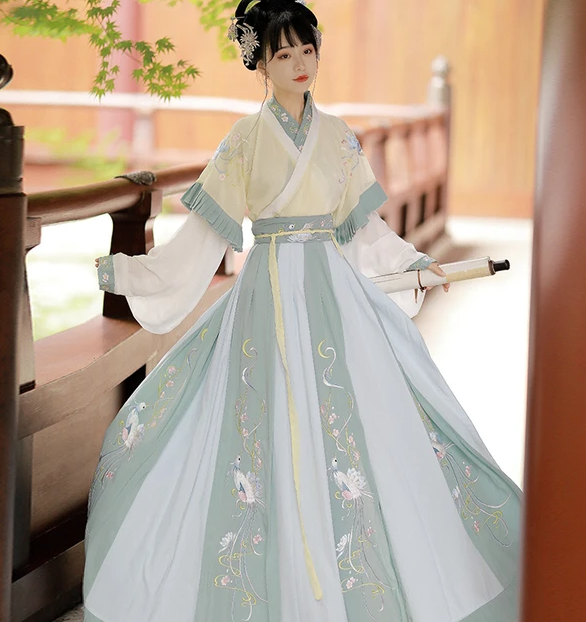There are various types of Hanfu collars such as Jiaoling Youren, Duijin, Shuiling, and variations featuring Pankou knots.
Types of Hanfu Collars
Hanfu collars not only serve a functional purpose but also signify various cultural, regional, and historical nuances. The design, stitching, and even the manner in which these collars close or open offer insights into different eras and locales within Chinese history.

Jiaoling Youren (交领右衽)
Jiaoling Youren is one of the most traditional types of Hanfu collars. This style features a cross-collar, with the right side folding over the left. It is mostly seen in Shenyi, Ruqun, and other traditional Hanfu garments. This style has its roots deep in ancient China and has been the standard for ceremonial dresses and formal wear. The design signifies both cultural depth and a kind of poetic elegance. It is often accompanied by Pankou knots for fastening.
Key Features:
- Cross-collar style
- Right-over-left folding
- Often seen in formal wear
- May feature intricate embroidery or patterns
Duijin (对襟)
Duijin, or the straight collar, deviates from the cross-collar style, offering a more symmetrical aesthetic. This type of collar opens down the middle and is common in both men’s and women’s Hanfu. It offers more ease of movement and can be found in a variety of fabrics and designs. Duijin is often the choice for casual and semi-formal occasions.
Key Features:
- Straight, symmetrical collar
- Middle opening
- Versatile in terms of occasion suitability
- Common in Ming dynasty Hanfu styles
Shuiling (水准)
Shuiling collars are less common but have a unique rounded collar that does not overlap. This is often seen in children’s Hanfu and in some women’s dresses. Shuiling adds a youthful and playful touch to the outfit, making it appropriate for festive events and casual outings.
Key Features:
- Rounded collar
- No overlapping
- Popular in children’s garments
- Often seen in lighter fabrics like silk and linen
Pankou Knots and Collar Variations
Pankou knots are the traditional Chinese “frog” fasteners used to secure the collars of Hanfu dresses. These are not only functional but also add an aesthetic element to the garment. While Pankou knots are common in Jiaoling Youren, they can also be seen in other types of collars as decorative elements. Other variations may include additional embroidery, beading, or even small tassels that add extra flair.
Key Features:
- Traditional Chinese fasteners
- Aesthetic and functional
- Can be seen across different collar types
- Adds decorative elements like embroidery and tassels
Regional Variations
Regional variations in Hanfu collars provide a fascinating lens through which to explore China’s vast geographical and cultural diversity. Whether it’s the colder northern regions or the warmer southern parts of China, the designs and fabrics used in Hanfu collars often vary. Understanding these regional differences is vital for appreciating the richness and complexity of Hanfu as a cultural garment.
Northern vs Southern Hanfu Collars
Northern Hanfu collars often feature thicker materials like wool or heavy brocade to provide warmth in colder climates. The collars are generally tighter and may come up higher on the neck. These designs may feature more robust and ornate Pankou knots to secure the garment while adding an aesthetic touch.
Key Features:
- Thicker materials like wool or heavy brocade
- Higher and tighter collars for added warmth
- Robust Pankou knots and ornamentation
On the other hand, Southern Hanfu collars cater to a warmer, more humid climate. Lighter fabrics like silk and linen are more common, and the collars tend to be looser and more open, allowing for better air circulation. These designs might feature more delicate embroidery and a lighter color palette.
Key Features:
- Lighter fabrics such as silk and linen
- Looser and more open collar designs
- Delicate embroidery and lighter color palette
Hanfu Collars in Minority Cultures
China is home to 56 ethnic groups, and each has its own unique take on traditional clothing. Minority cultures such as the Tibetans, Mongols, and Manchu have distinct Hanfu collar designs that reflect their unique cultural influences.
Tibetan Hanfu, for instance, incorporates collars with intricate patterns inspired by Tibetan Buddhism. These collars often feature spiritual motifs and bright colors.
Key Features:
- Spiritual motifs
- Bright colors
- Influenced by Tibetan Buddhism
Mongolian Hanfu collars reflect a more nomadic lifestyle, often featuring wider and more open designs suitable for horseback riding. The embroidery may include patterns like swirls and loops that reflect the Mongolian script.
Key Features:
- Wider, more open designs
- Swirl and loop embroidery patterns
- Suitable for a nomadic lifestyle
Manchu collars are distinct, often featuring a high, standing collar, similar to what one might find in a Qi Pao. The designs may include intricate dragon or phoenix motifs to symbolize imperial authority.
Key Features:
- High, standing collar
- Dragon or phoenix motifs
- Symbols of imperial authority
Modern Adaptations
The adaptation of Hanfu collars into modern fashion is a fascinating development, bridging the gap between tradition and contemporary trends. As global fashion becomes increasingly eclectic, Hanfu collars are receiving a modern makeover. While traditional elements continue to be cherished, innovative designs and fabrics are bringing a contemporary flair to these age-old styles.
Hanfu Collars in Contemporary Fashion
The transition of Hanfu collars into contemporary fashion is a testament to their timeless appeal. Modern designers are incorporating elements like zippers and buttons as alternatives to traditional Pankou knots. Some brands are even blending Hanfu collars with Western-style shirts and dresses, creating fusion garments that appeal to a broader audience.
Key Features:
- Introduction of zippers and buttons
- Fusion with Western-style garments
- Variations in fabric, including the use of sustainable materials
- Adaptations for casual and everyday wear
Fashion-forward individuals may find Hanfu collars appearing in streetwear, made from casual fabrics like cotton or even denim. These adaptations make Hanfu collars more accessible and wearable for everyday occasions, contributing to the rising popularity of Hanfu in general.

Cross-cultural Influences
Cross-cultural influences are adding new layers of complexity and innovation to Hanfu collars. Designers are incorporating features from other cultural garments, such as the Japanese Kimono or the Korean Hanbok. This fusion creates unique, hybrid styles that appeal to a global consumer base interested in world fashion.
Key Features:
- Incorporation of elements from Kimono and Hanbok
- Hybrid styles that appeal to a global audience
- Creation of limited-edition, cross-cultural Hanfu pieces
For example, some designers are integrating high, standing collars similar to those found in Qi Pao or adding Kimono-inspired sashes and obis as fasteners. Such innovative additions not only bring fresh aesthetics but also offer functional benefits, like ease of wear or increased comfort.